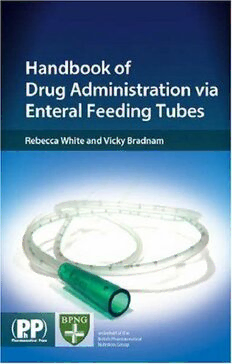
Handbook Of Drug Administration Via Enteral Feeding Tubes PDF
590 Pages·2007·5.425 MB·English
Most books are stored in the elastic cloud where traffic is expensive. For this reason, we have a limit on daily download.
Preview Handbook Of Drug Administration Via Enteral Feeding Tubes
Description:
The increase in awareness of the importance of adequate nutritional intake has increased the use of enteral feeding tubes for both short and long term feeding in both primary and secondary care. An enteral feeding tube provides a means of maintaining nutritional intake when there is limited access to the gastrointestinal (GI) tract. Finding a suitable drug formulation for administration to a patient with limited GI access can be difficult. Although parenteral administration can be used and often guarantees 100 per cent absorption, repeated intravenous, subcutaneous or intramuscular injections are associated with complications and are not suitable for long-term use. There are also other routes that can be considered such as transdermal, buccal, rectal or topical but the drugs available in these preparations are limited. In these patients the feeding tube is often the only means of enteral access and increasingly is being used as a route for drug administration. However, their use for the administration of drugs may induce formula intolerance, or result in less than optimal drug absorption. This handbook is designed to provide all the necessary guidance on the safe administration of medicines via this route in one resource.
See more
The list of books you might like
Most books are stored in the elastic cloud where traffic is expensive. For this reason, we have a limit on daily download.
